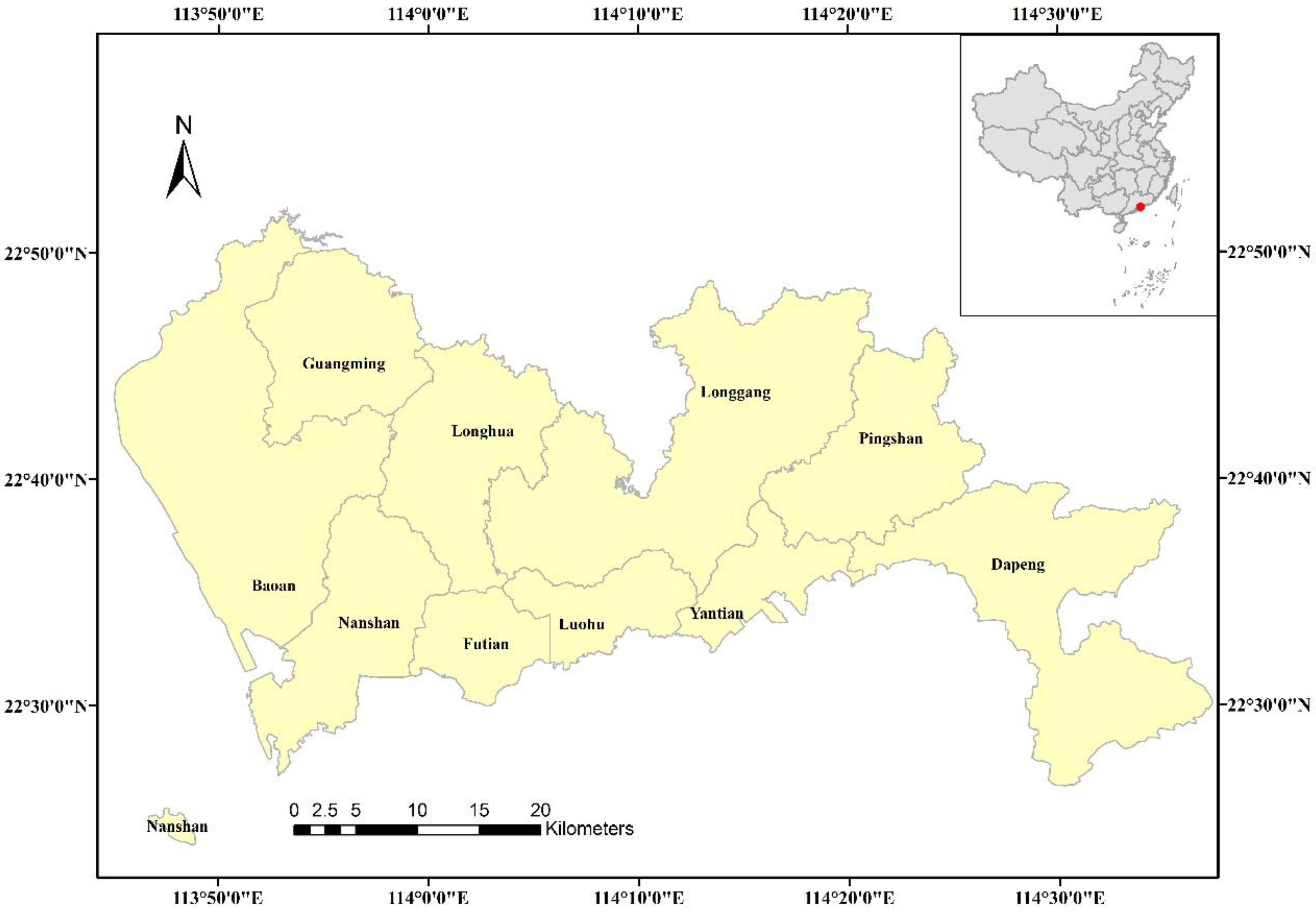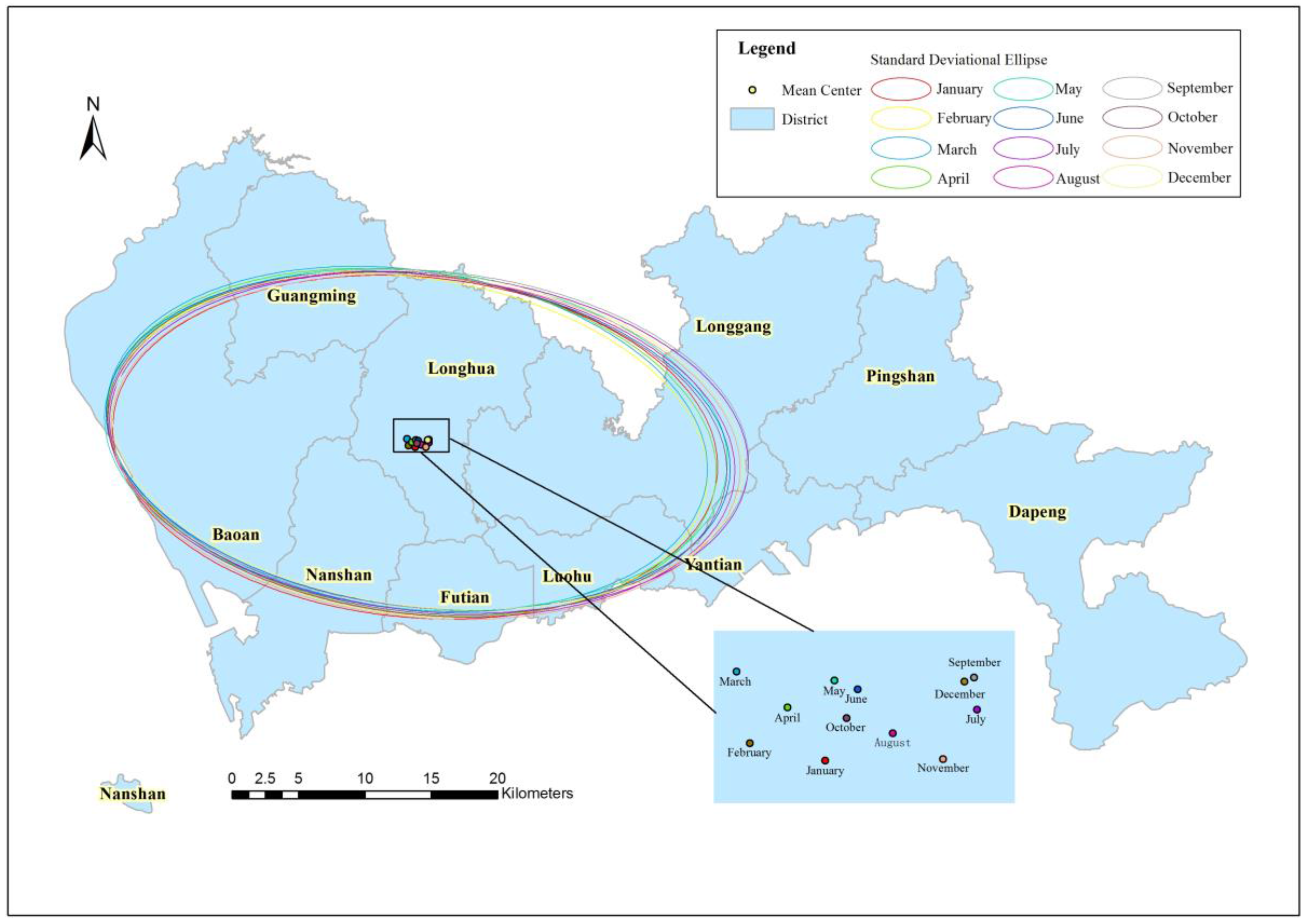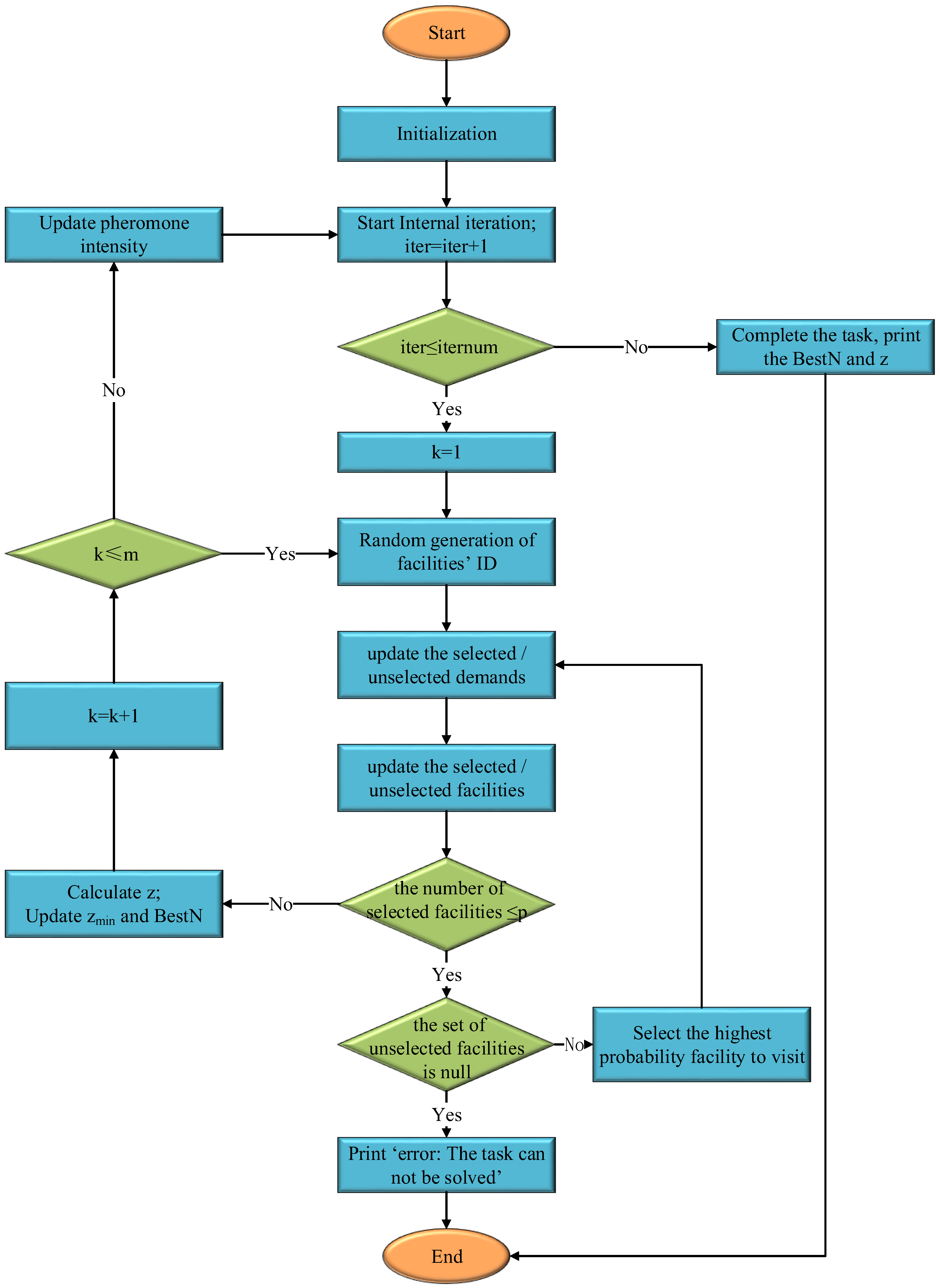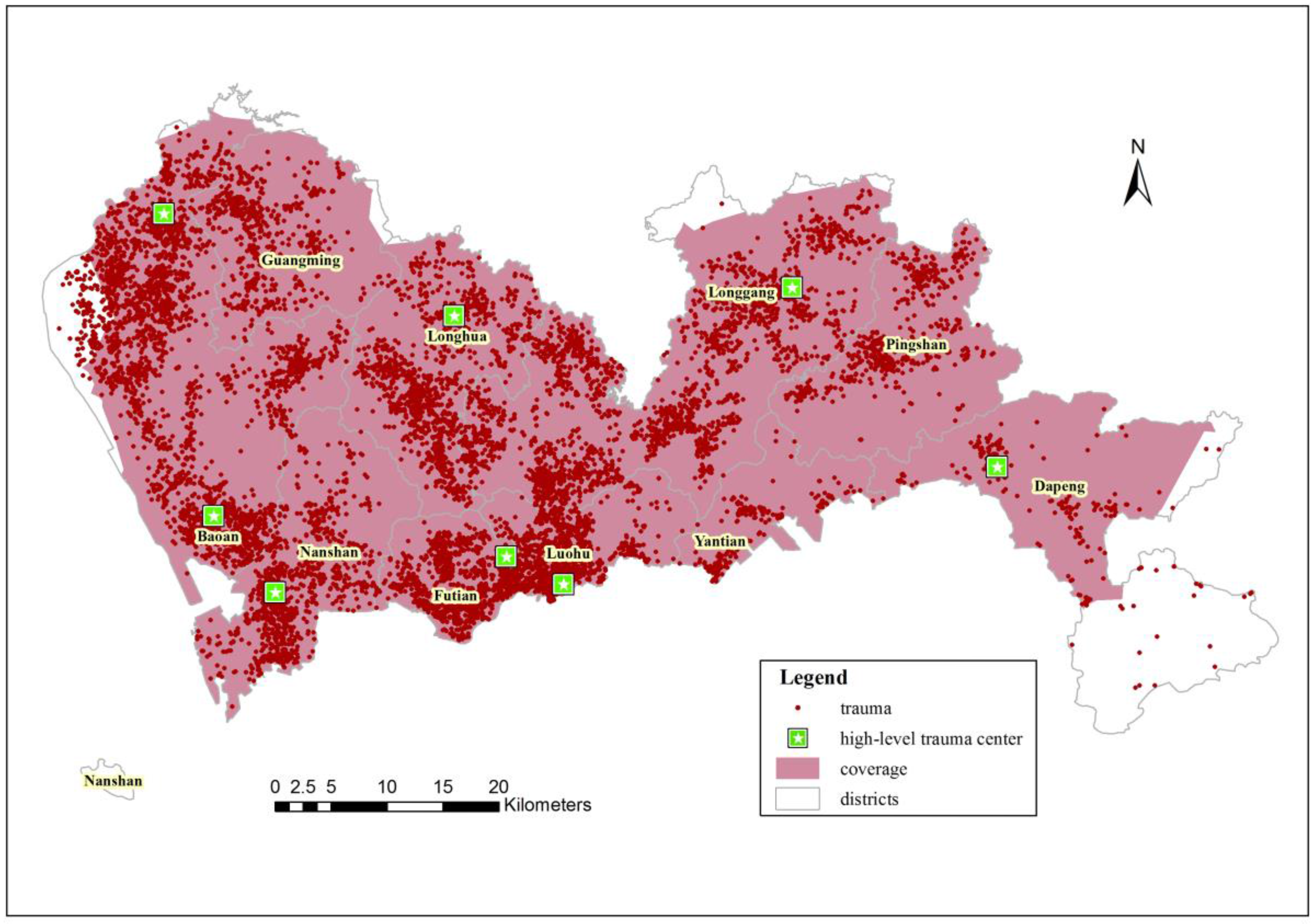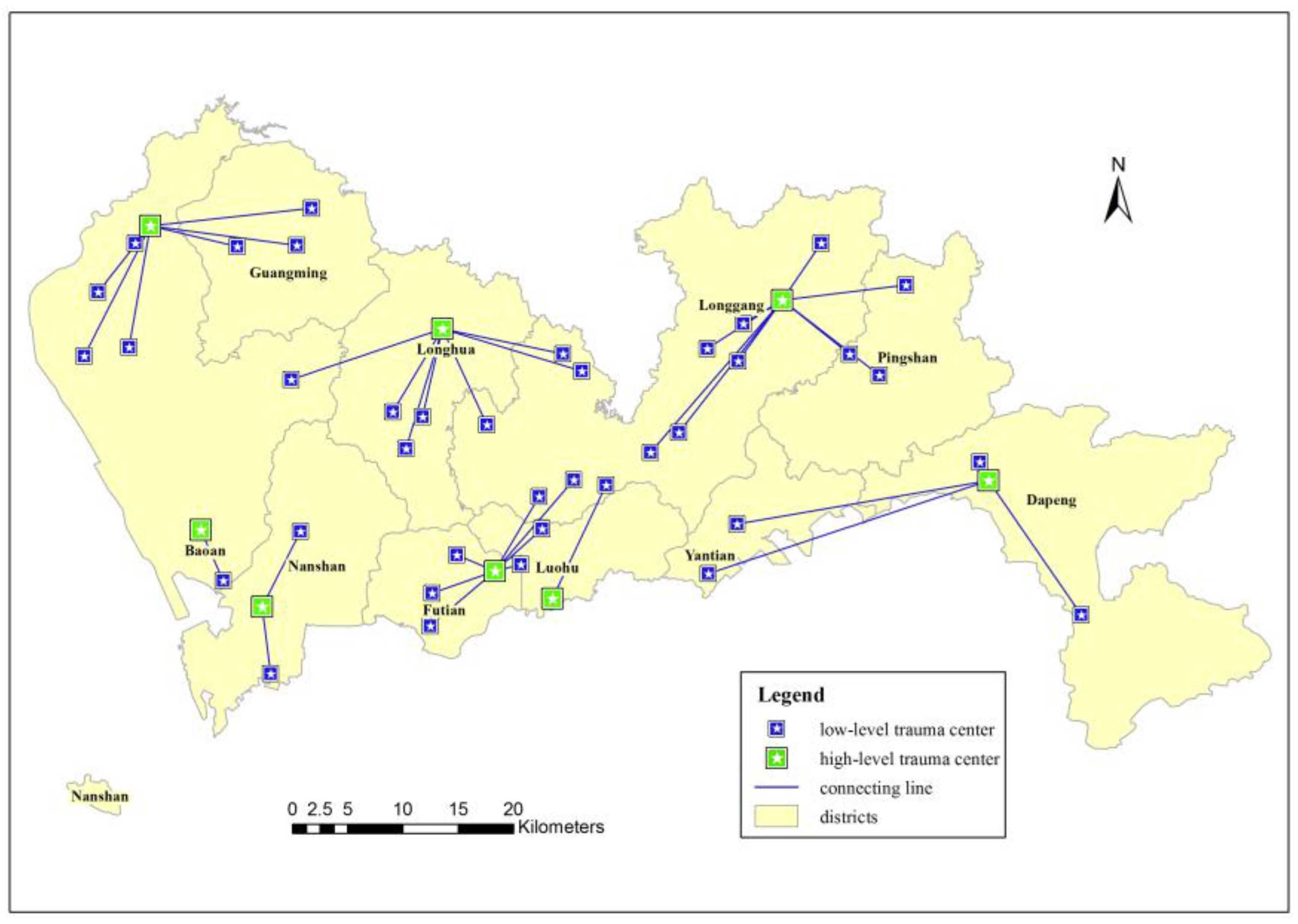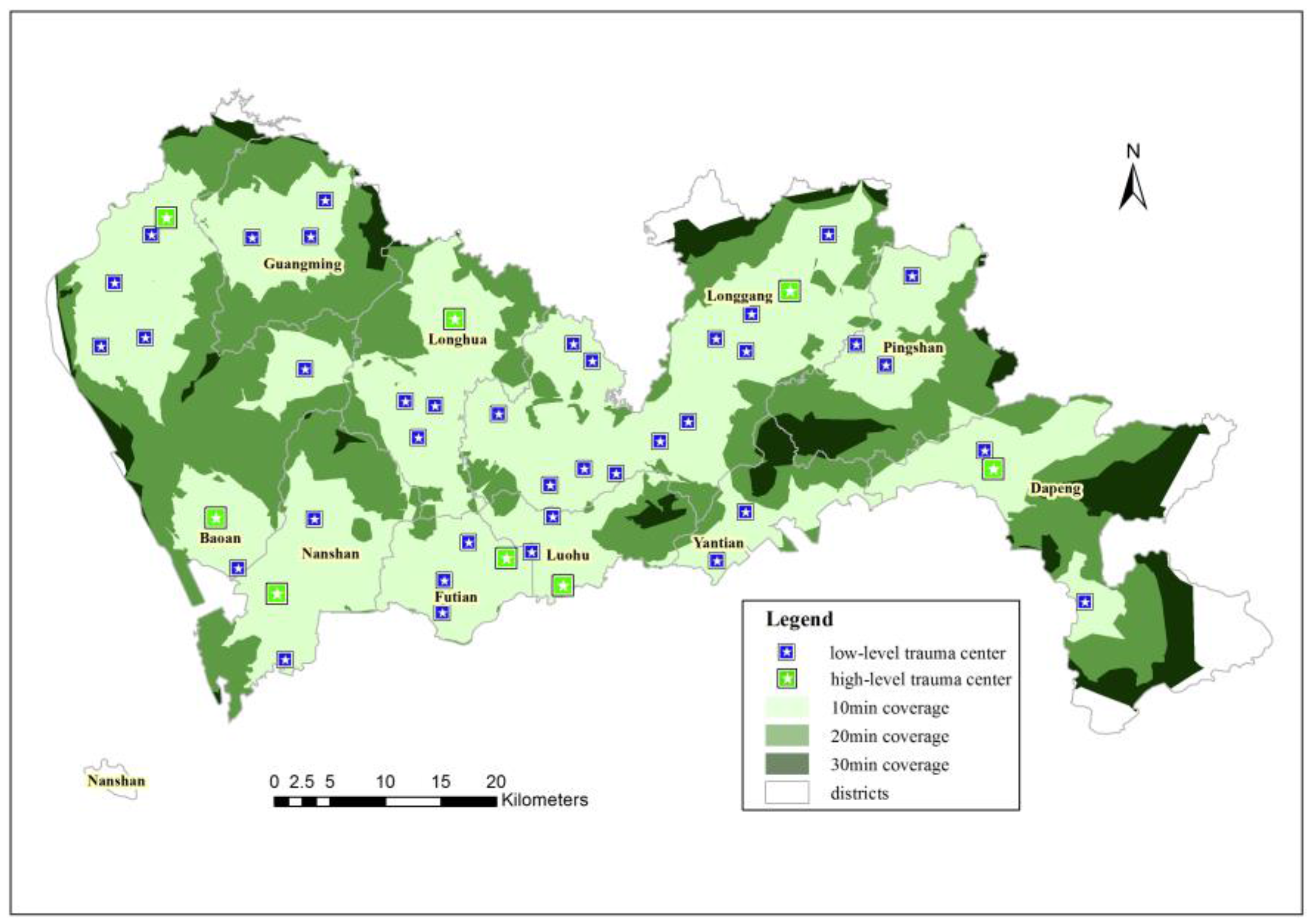2.3.1. Location-Allocation Models
A location-allocation model is a method used to determine the optimal locations of facilities and to spatially allocate facilities based on the demands. Classical research regarding location-allocation models includes the P-center Model [
38], the P-median Model [
38] and the Covering Model. The Covering Model includes the Location Set Covering Model [
39] and the Maximal Covering Location Model [
40]. The major difference between these models is associated with the criteria or objective function used to solve location problems. However, as the complexity of location problems increases, the basic location models noted above—which consider only a single objective—cannot solve the problems; thus, the concept of a comprehensive location model was proposed. Comprehensive location models are usually based on a basic location model and are established according to different location objectives and the hierarchical attributes of facilities.
For example, urban shelters are hierarchical facilities because they are divided into different levels according to the types of services they offer, including emergency shelters, temporary shelters and long-term shelters. At the first level are emergency shelters, which offer basic services for sudden disastrous accidents. At the next level are temporary shelters, which offer relatively comprehensive services to solve crowding problems experienced by the emergency shelters and to mitigate the effects of secondary disasters. At the third level are long-term shelters, which offer the most comprehensive services for victims whose housing was seriously damaged. Low-level facilities offer low-level services, and high-level facilities offer high-level services. Because of the different requirements, a fixed location-allocation model cannot solve this type of problem, and personalized location-allocation models of each facility level constitute a hierarchical location-allocation model [
41].
In general, a hierarchical facility system can be separated into two types: nested hierarchy systems and non-nested hierarchy systems. In a nested hierarchy system, the high-level facilities offer both high- and low-level services. In a non-nested hierarchy system, each facility level offers different services. A trauma center system is a nested hierarchy system in which low-level facilities serve as first responders to offer basic emergency services, while high-level facilities offer not only basic emergency services but also services that low-level facilities cannot offer for trauma patients in serious condition. Therefore, the primary purpose of a low-level trauma center is to cover all demands within a certain timeframe to guarantee basic emergency services and control over the situation “in time”, where “in time” reflects the emergency standard of the “platinum 10 min”, which is the maximum time in should take trauma emergency services to arrive at a trauma scene. The location selection of high-level trauma centers requires the consideration of not only the minimum total weighted travel time from the low-level to the high-level trauma centers but also the area coverage capability, medical treatment capability and construction costs.
In this study, we use the Location Set Covering Model to solve the location-allocation problem of low-level trauma centers, which is used to locate emergency service facilities such as fire stations and hospitals. The aim of this model is to determine the minimum cost required to construct the facilities and to determine their locations so that each demand is covered by at least one facility in a specified threshold (distance or time). When the cost of constructing each facility is equal, the aim is to minimize the number of eligible facilities and to determine their locations.
The objective function is described as follows:
where
I and
J denote the set of trauma demands and candidate low-level trauma centers, respectively;
denotes the construction cost when a low-level trauma center is located at
j;
denotes a low-level trauma center that is located at
j, and
otherwise;
denotes the set of low-level trauma centers that can cover the trauma demand
i within a specified threshold;
T denotes the “platinum 10 min”; and
denotes the travel time between
i and
j.
Equation (1) minimizes the total construction costs of the low-level trauma centers; Equation (2) ensures that each trauma demand is covered by at least one low-level trauma center; Equation (3) ensures that the value of the variable is 0 or 1.
Meanwhile, we use a multi-objective model that considers the response, coverage, treatment and cost capacities of the candidate trauma centers to solve the location-allocation problem of high-level trauma centers. Compared to the basic location model, the considerations of the multi-objective model are more comprehensive and specific. The objective function is as follows:
where
I and
J denote the set of trauma demands and candidate high-level trauma centers, respectively;
denotes the trauma demands at node
i;
denotes the travel time between
i and
j;
if the trauma demand
i is assigned to a high-level trauma center
j, and
otherwise;
if a trauma demand
i is covered by a high-level trauma center, and
otherwise;
denotes the medical quality of high-level trauma center
j;
denotes the construction cost when a high-level trauma center is located at
j;
denotes that a high-level trauma center is located at
j, and
otherwise; and
p denotes the number of high-level trauma centers to be located.
Equation (4) minimizes the total weighted travel time between high-level trauma centers and trauma demands; Equation (5) maximizes the coverage of the trauma demands; Equation (6) maximizes the total medical quality of the high-level trauma centers; Equation (7) minimizes the total construction cost of the high-level trauma centers; Equation (8) ensures that the desired number of high-level trauma centers is determined; Equation (9) ensures that each trauma demand is covered by a high-level trauma center; Equation (10) ensures that only the selected high-level trauma centers can provide service for trauma demands; and Equations (11)–(13) ensure that the value of the variable is 0 or 1.
To reduce the number of contradictory objectives, a weighted method is often used to convert the multiple objectives to a single objective. Combining the above objective functions, the final objective function of high-level trauma centers is as follows:
where
,
,
, and
are the weight coefficients of each objective function, and the result includes constructing the judgment matrix, inviting an expert to evaluate the function and performing a consistency check [
28].
2.3.2. Ant Colony Optimization
Finding the optimal locations of trauma centers is a typical NP problem that requires solving a large number of polynomials. Compared to exhaustive methods, heuristic methods such as ACO can save a great deal of computational time. ACO, which was introduced by Dorigo et al. [
42], is a popular intelligent heuristic algorithm that was inspired by the foraging behavior of ants. This type of ant behavior is a collective behavior in which each ant deposits a chemical substance (pheromone) on a path from the anthill to food; the more pheromone that is deposited, the greater the probability that other ants in the community will follow the path. The intensity of the pheromone weakens over time. Eventually, the path with the highest pheromone intensity will be the shortest.
ACO has often been used to solve the Travelling Salesman Problem (TSP), but it has also been applied to solve the Maximum Independent Set Problem (MISP), Knapsack Problem (KP), and Quadratic Assignment Problem (QAP), among others [
43,
44,
45,
46]. ACO can also be applied to solve location-allocation problems.
Figure 5 shows the flowchart of the ACO algorithm used to solve the location-allocation problem involving high-level trauma centers in this study. The ACO algorithm process is as follows (
Figure 5).
Step 1: Initialization of the algorithm (including iternum (maximum iterations), m (number of ants), (narrowing parameter), (evaporation rate), ρ (volatilization parameter), Q (pheromone intensity), zmin (minimum z), and so on).
Next, import (the set of candidate high-level trauma centers), (the set of trauma demands), (the travel time matrix between trauma demand i and high-level trauma center j), (the set of trauma demands that can be addressed from high-level trauma center j within the “Golden Hour”), and Zj (the matrix of candidate high-level trauma centers, which calculated by the response matrix, coverage matrix, treatment matrix and cost matrix of the candidates).
Then, set (initial number), (initial time), (the set of selected high-level trauma centers at time t is null), (the set of unselected high-level trauma centers at time t is universal), (the set of selected trauma demands at time t is null), (the set of unselected trauma demands at time t is universal), (initial value), and (the optimal locations of high-level trauma centers).
Step 2: Start internal iterations, and when the iteration number reaches iternum, go to Step 11.
Step 3: Randomly generate f candidate high-level trauma center IDs for ant k to visit. Simultaneously, update the set of selected/unselected high-level trauma centers and the selected/unselected trauma demands.
Step 4: If the number of selected high-level trauma centers reaches p (the number of required facilities), then go to Step 7.
Step 5: If the set of unselected high-level trauma centers is null, then go to Step 10.
Step 6: Select the high-level trauma center with the highest probability for ant
k to visit according to Equation (15). Simultaneously, update
t to
t+1, and update the selected/unselected high-level trauma centers and selected/unselected trauma demands. Then, go to Step 4.
In Equation (15),
denotes the probability that ant
k will visit high-level trauma center
j at time
t,
denotes the pheromone intensity of high-level trauma center
j,
denotes the heuristic function in Equation (15),
denotes the set of high-level trauma centers that ant
k has not visited at time
t,
α denotes the narrowing parameter,
β denotes the pheromone evaporation rate, and
iter denotes the number of iterations.
In Equation (16), denotes the set of trauma demands that ant k has not visited at time t, denotes the set of trauma demands that can be covered by high-level trauma center j, and denotes the number of trauma demands that ant k has not visited at time t.
Step 7: Calculate z. If z < zmin, then z = zmin, and BestN = .
Step 8: Start the next ant’s visit, k = k + 1; if k ≤ m, then go to Step 3.
Step 9: Update the pheromone intensity according to Equation (16) and then go to Step 2.
In Equation (17),
denotes the volatilization parameter,
iter denotes the number of iterations, and
denotes the sum of the pheromone intensities at high-level trauma center
j.
In Equation (18),
denotes the pheromone intensity of ant
k at high-level trauma center
j.
In Equation (19), Q denotes the pheromone intensity, denotes the number of high-level trauma centers that ant k has visited, and denotes the set of high-level trauma centers that ant k has visited at time t.
Step 10: Print “Error: The task cannot be solved”, then go to Step 12.
Step 11: Complete the task and print the values of BestN and z.
Step 12: End.
